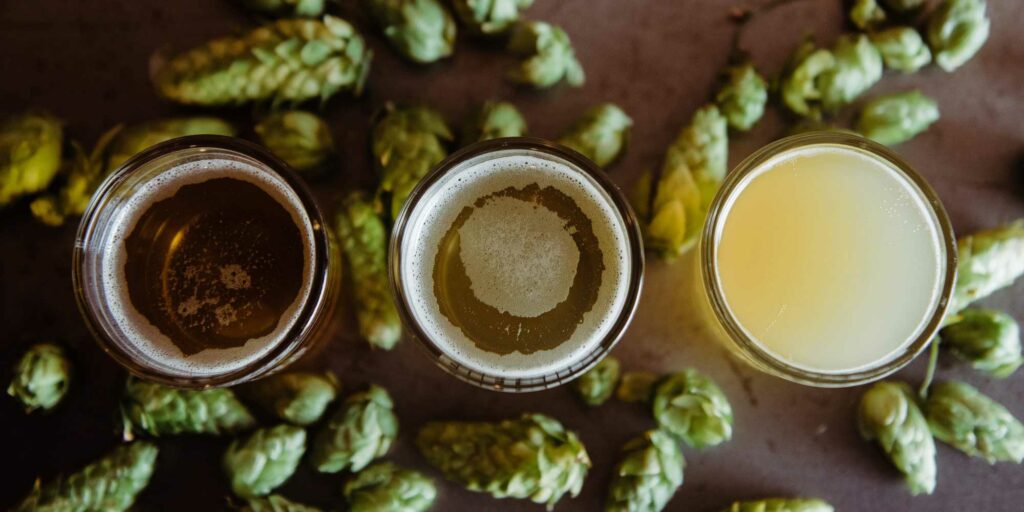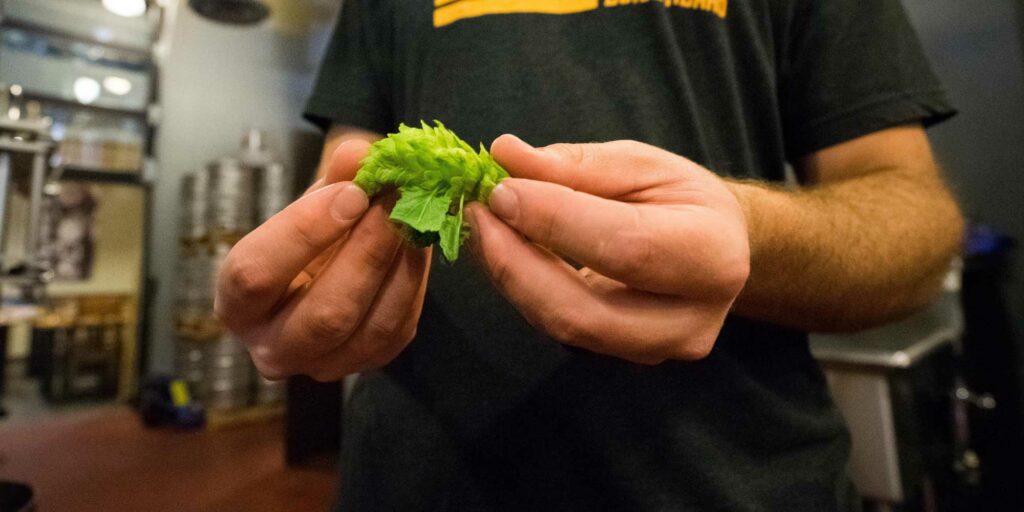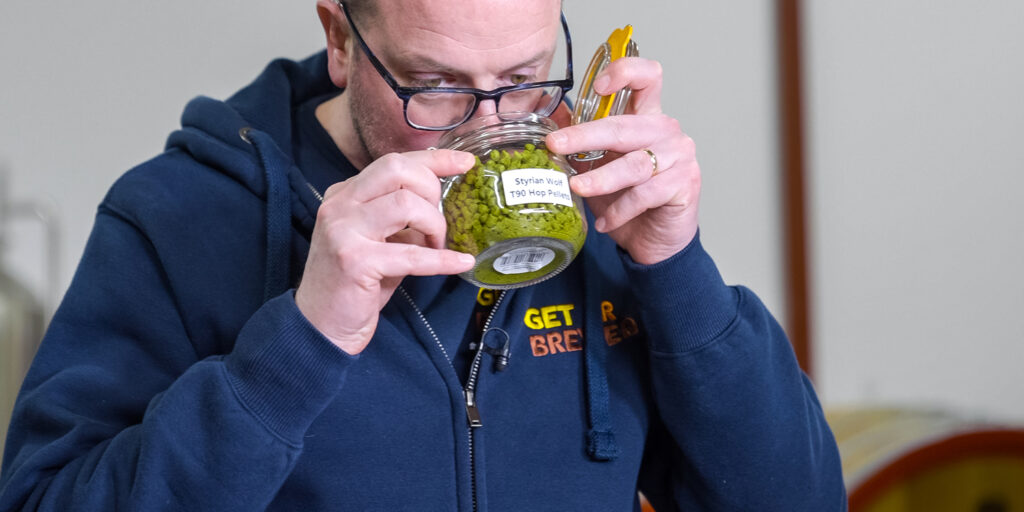From Bitter to Beautiful: The Art of Balancing Hops in Beer
Have you ever taken a sip of beer and noticed a burst of floral, citrusy, or earthy flavours? That is the work of hops! Hops are the dried flowers of a plant in the Cannabaceae family used for bitterness and flavour in beer. Hops come in various forms, like cones, pellets, and plugs, imparting different characteristics to the beer. Learning how to balance the hops in your beer can turn an ordinary brew into a masterpiece. Let’s explore balancing hops in beer and how to get the most out of your hop pellets.

The history and significance of hops in beer brewing
Hops are the cone-shaped fruits of a plant that contain acids and essential oils used for bittering and aromas in beer. Hops likely originated in China and were first documented in an 8th-century Bavarian abbey. Before hops, beer was flavoured and preserved with gruit, combining heather, mugwort, and other herbs and spices. Despite being an essential ingredient in beer today, some initially viewed hops with suspicion. Christian mystic and naturalist, Hildegard of Bingen even stated that “hops were not very useful. [They] make the soul of man sad and weigh down his inner organs.” However, hops’ flavour and preservative qualities eventually won over the brewing community.
Advanced hop products have allowed brewers to create new and exciting beer flavours in recent years. One example of a company embracing this is GetErBrewed. Geterbrewed provides hops in multiple pack sizes, which provide unique aromas and flavours that add complexity to beer. Craft brewers, in particular, have embraced the potential of hops, moving away from tasteless lagers to a beer packed with hop flavour. Today hops play a crucial role in creating the bitterness and aroma that we associate with many types of beer.
The role of hops – flavour, aroma, and bitterness
Beer comprises four essential ingredients: water, malt, hops, and yeast. Each of these elements contributes to the final taste and aroma of the beer. When it comes to hops, they play a significant role in beer’s flavour, aroma, and bitterness.
Hops are the female flower of the hop plant, which produces two types of acids – alpha and beta. During brewing, these acids dissolve in the wort, adding bitterness to the final beer. However, hops do much more than create bitterness in beer. They also contribute unique oils that add to the beer’s overall flavour profile, giving it hints of citrus, pine, or floral notes.
Furthermore, hops are an excellent preservative. This means beer brewed with hops has a longer shelf life than beer brewed without it.
During brewing, hops are added to the boiling wort, releasing their bitter and aromatic compounds into the mixture. Different hop varieties can be added at different times during the boil, impacting the beer’s overall flavour profile. For example, adding hops earlier in the boil will create a more bitter beer. While adding them later in the process can produce a beer with a more delicate hop aroma. Creating a balance of hops in a beer takes skill and requires you to consider blends, oil content and how they work in harmony with the malt bill and yeast selection.
There are two types of hops: old world and new world.
- Old-world hops, such as the UK’s Fuggles or Germany’s Hallertau, have been used for centuries. These produce more earthy, floral, and herbal notes.
- New world hops, such as the US’s Cascade or Australia’s Galaxy, are recent additions to the brewing world. These often create more fruity, citrusy, and tropical flavours.
In addition, thanks to advanced hop products, brewers have more options and techniques available than ever. This allows them to experiment and create unique, complex, balanced beers.
Different types of hops and their characteristics
Hops come in a variety of types, each with its unique characteristics. These different hops can be used to create a variety of flavours and aromas in beer. Here are some of the most popular types of hops used in beer brewing:
- Cascade hops have a moderate alpha acid range of 4% to 6.3%. Known for their floral and citrusy flavour and aroma.
- Centennial hops have a higher alpha acid range of 8% to 9%. They are known for their floral, spicy, and citrusy flavours.
- Simcoe hops have a high alpha acid range of 12.5% to 14%. Known for their piney, citrusy, and earthy flavours.
- Amarillo hops have an alpha acid range of 8% to 11.5% and are known for their floral and citrusy flavours.
- Chinook hops have an alpha acid range of 11% to 14%. They are known for their spicy, piney, and grapefruit flavours.
- Citra hops have a very high alpha acid range of 11% to 16%. These are known for their tropical fruit and citrusy flavours.
- Mosaic hops have a very high alpha acid range of 13.5% to 16%. They are known for their complex flavours of tropical fruit, berry, and citrus.
- Other popular types of hops include Columbus (14% to 17%), Styrian Goldings (3.5% to 6.5%), Northern Brewer (7% to 10%), and Willamette (4% to 6%).
With the availability of advanced hop products and the online hop merchant Geterbrewed hops, it’s easy for homebrewers and professional brewers alike to experiment with different hop combinations to create unique and delicious beers.

Techniques for adding hops to beer
There are various techniques for adding hops to beer, each resulting in different flavours and aromas.
- Mash Hopping – This involves adding hops directly to the mash during brewing.
- Wort Hopping – Where hops are added to the wort as it runs off the mash. This results in a smoother bitterness.
- During the boil – ops can be added at different times to control the flavour and bitterness. Early addition will result in more bitterness, while later addition will provide more aroma.
- Hop Bursting – Hops can be added near the end of the boil for a burst of flavour and aroma.
- Hop Stand or Whirlpool Hopping – This involves adding hops to the wort after the boil. Allowing them to steep for a period of time. This can result in a more intense hop flavour and aroma.
- Dry Hopping – Adding hops directly to the fermented beer and allowing them to steep for a period of time. This results in a hoppy aroma without adding much bitterness.
No matter the technique, choosing the right hops is key and balancing hops in beer is critical to success. To do that consistently, we recommend you buy Geterbrewed hops.
Balancing hops in beer with other ingredients
When it comes to creating a balanced beer, hops play a crucial role in offsetting the sweetness of the malt. Alpha acids in hops provide the bitter backbone of the beer. While essential oils and resins provide unique flavours and aromas. But it’s not just about hops – the right yeast strain can enhance hop flavour and aroma.
Certain yeast strains respond well to biotransformations with hops when added during active fermentation. For example, an English yeast strain may produce fruity esters that complement the citrusy flavour of American hops. In contrast, a Belgian yeast strain may enhance noble hops’ spicy and earthy characteristics.
To ensure balance, it’s important to measure the IBU rating of hops using a recipe calculator. This will help you determine how much bittering hops to add to achieve the desired level of bitterness. But keep in mind that growing conditions and agricultural practices can affect the quality of hops. It’s always a good idea to source your hops from a reputable supplier like GetErBrewed.
In addition to balancing hops with malt and yeast, you can experiment with other ingredients. Fruits, spices, and botanicals to create complex and unique flavour profiles. The key is to find the right balance of ingredients that work together harmoniously.
Understanding the IBU to balancing hops in beer
Finding the right balance between sweetness and bitterness is essential in getting a great-tasting beer. Hops play a crucial role in creating that bitterness. The International Bitterness Units (IBU) scale is the standardized way to measure the relative bitterness of a beer. The IBU scale measures the concentration of iso-alpha acids in beer, compounds produced by the hops during brewing. The higher the concentration, the higher the IBU. A beer with an IBU of 0 would have no perceived bitterness. While a beer with an IBU of 120 would be incredibly bitter.
However, it’s important to note that the perception of bitterness is subjective and varies from person to person. Additionally, other factors such as malt sweetness, alcohol content, and hop aroma can all affect how a beer’s bitterness is perceived.
Different beer styles have different ideal IBU ranges. For example, a light lager might have an IBU of 8-12, while an American IPA might have an IBU of 40-70. Here are the IBU ranges for a few other common beer styles:
- Amber Ale: 20-40
- American Lager: 5-10
- American Pale Ale: 30-50
- Belgian Dubbel: 15-25
- Belgian Tripel: 20-45
- Blonde Ale: 15-30
- Double IPA: 60-100
- English Bitter: 25-35
- German Pilsner: 25-45
- Hazy IPA: 30-70
- Imperial Stout: 50-90
- IPA: 40-70
- Light Lager: 10-20
- Pilsner: 25-45
- Porter: 25-50
- Wheat Beer: 10-15
Understanding the IBU scale can help brewers achieve the right balance of bitterness in their beers. It’s important to remember that it’s just one factor in creating a great-tasting beer. With the right combination of malt, yeast, and hops from Geterbrewed, a skilled brewer can create a delicious and well-balanced beer that satisfies even the most discerning of palates.

How to choose the right hops for beer styles
Choosing the right hops for different beer styles, there are a few key factors to consider. Balancing hops in beer requires consideration of several factors: the variety, oil content, alpha acid percentage, blend, and addition time. Hops are a crucial ingredient in the beer brewing process, as they impart bitterness and flavour, help maintain a beer’s foamy head, and lend antibacterial qualities.
The amount of bitterness and the type of aromas that hops deliver to beer depend on various factors. Including the specific hop variety, the quantity of hops used, and the timing of their addition during brewing.
Noble Hops are often the go-to for traditional European beer styles, such as German lagers and Belgian ales. These hops, including Styrian Goldings, Hallertauer Mittelfrüh, Tettnanger, Spalt, and Saaz, offer gentle floral aromas, earthy spiciness, and a touch of citrus. They contribute to a balanced and subtle flavour profile that complements these classic beer styles.
On the other hand, American hop varieties have gained popularity for their bold and aromatic qualities. Some top American hop varieties available today include Cascade, Citra, Mosaic, Amarillo, and Simcoe. Each of these hops offers unique flavour and aroma characteristics, ranging from citrusy and tropical to piney and floral.
Blending hops can also be a great way to achieve specific flavour profiles. Experimenting with different hop combinations, such as blending fruity and floral hops with earthy and piney hops, can create complex and desirable flavour profiles in your beer.
When selecting hops for your beer, sourcing them from a reputable supplier like Geterbrewed is essential to ensure quality and consistency. With the wide variety of hop options available, you can explore different flavour possibilities and create the perfect balance of hops for any beer style you choose to brew.